Espresso has such a unique taste, body, and mouthfeel that you could think that they need different coffee beans.
To make it even more confusing, roasters often label their blends and single origins as “espresso” – but that doesn’t mean putting those coffee beans in any coffee maker would result in an espresso.
I’ll be straightforward. Coffee brands aren’t trying to mess with your head. There are some differences in their roasted coffee beans that make them more or less suitable for espresso.
Moreover, brewed coffee and espresso differ in taste, but what sets them apart are brewing methods, not the difference between espresso and coffee beans.
Below, I will explain in further detail the difference between espresso beans and coffee beans, as well as dig deeper into the technical aspects of coffee and espresso brewing.
In short: Espresso vs. Coffee
The differences between coffee and espresso are that:
- Espresso is more concentrated than black coffee.
- Coffee grounds for espresso are finer than for drip coffee.
- Espresso can only be made using an espresso machine. We can make black coffee using a wide range of coffee makers.
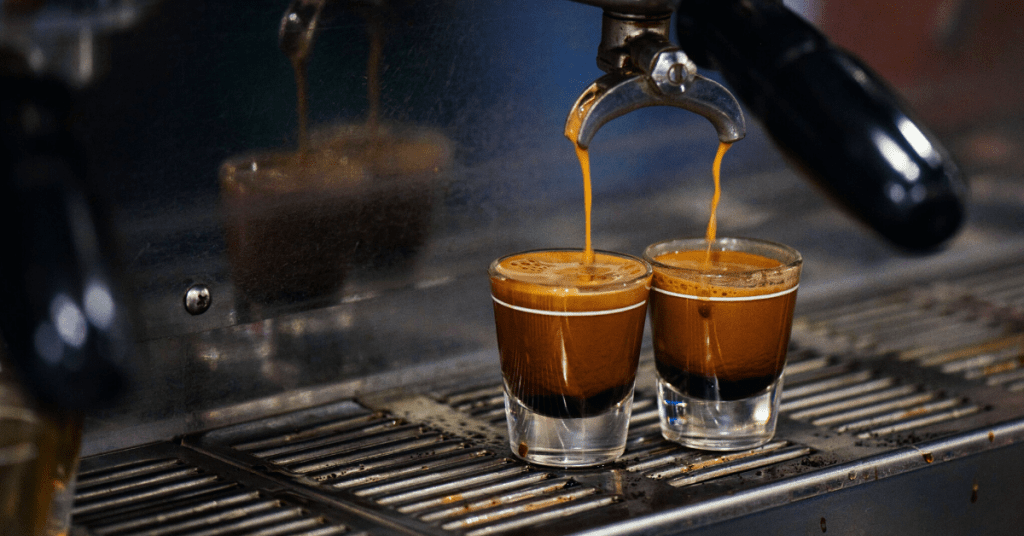
Photo by Kevin Butz on Unsplash
In other words, you can’t dial an espresso shot without a good grinder and an espresso machine.
Why?
Because an espresso machine can deliver a narrow stream of hot water at 9 bar of pressure through a flat bed of ground coffee.
I know, my opinion might not align with the general consensus. You might be raising an eyebrow by now because you read -or heard- that you can make an espresso with a Moka pot or an Aeropress.
But Moka pot and Aeropress coffees are bold, rich, concentrated coffee cups.
Not espresso.
What’s the difference between coffee and espresso?
Grind
Espresso needs very fine coffee grounds. The grind size plays a huge role in espresso quality. For this reason, a good quality burr coffee grinder is crucial for a decent espresso.
The rationale behind this is that making espresso requires delivering a huge amount of pressure over a flat bed of finely ground coffee.
We call this bed a puck, and if the particles are consistent, espresso will taste better. Many times, unpleasant sourness and bitterness in espresso come from a low-quality grinder producing too many fines or boulders.
Consistency isn’t enough. An excessively fine grind size will result in an overly bitter espresso, while a coarse grind will produce a sour shot. In extreme cases, it will end in a weaker too.

Photo by Dex Ezekiel on Unsplash
In contrast, brewing regular coffee requires a medium grind size. We use thick filters for drip coffee that allow fewer particles into the brew. For this reason, drip coffee has a lighter body. Additionally, without extra-pressure water clogs if the coffee grounds are too fine.
Brewing good filter coffee, in this regard, depends on your ability to tweak the grind size, more than anything else. Basically, because it’s more precise and easier to make little changes in grind size while keeping equal the rest of the variables.
Likewise, improving espresso shots implies adjusting grind size, observing the time of extraction, and looking at the portafilter during the process. Frequently, making a good espresso takes adjusting grind size, more than anything else. But, the decisive indicator isn’t the crema or the dialing time.
The decisive indicator of espresso quality is taste.
Dose
Brewing ratios, or in the case of espresso, dosing, is a major difference between drip coffee and espresso.
Traditional Italian espressos got as little as 7 gr of coffee resulting in tiny shots below 20 ml. Currently, is more common to find double shots at most cafés, with espresso having as much as 20 gr.
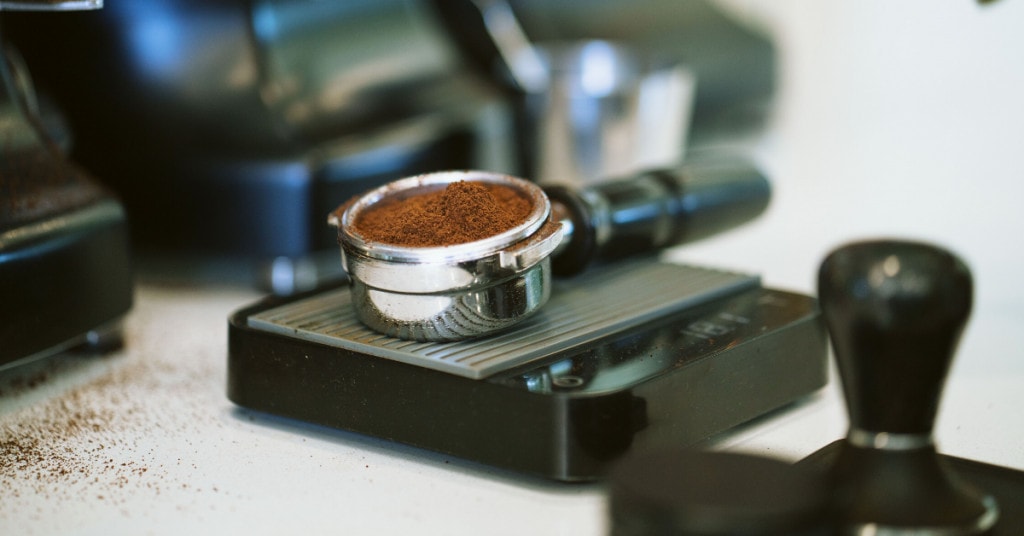
In contrast, we are used to having 15 gr to 20 gr of coffee to brew a 250 ml serving of black coffee.
Simply put, if we see a coffee cup as a solution, an espresso has 1 part of coffee per 2 parts of water. In contrast, regular coffee can have between 15 and 18 parts of water per part of coffee.
Brewing
Like I said before, pressure makes espresso extraction unique. 9 bars is the standard pressure that an espresso machine can produce regularly. It required a major technological advance to deliver this amount of pressure, both steadily and safely.
The brilliant minds of Angelo Moriondo, Luigi Bezzera, and Achille Gaggia set the foundations for today’s espresso technology. In doing so, modern espresso machines created a completely new type of coffee drink.
Commercial grade machines are different from prosumer and home espresso machines. It’s common to find home equipment that can deliver 15 bars of pressure, but this isn’t common for commercial-grade machines.
That said, higher pressure doesn’t mean better espresso.
A steady and clean extraction is better than an unstable one, and commercial espresso machines are superior in this aspect. Moreover, they can deal with a huge amount of servings in a short period of time without losing pressure.
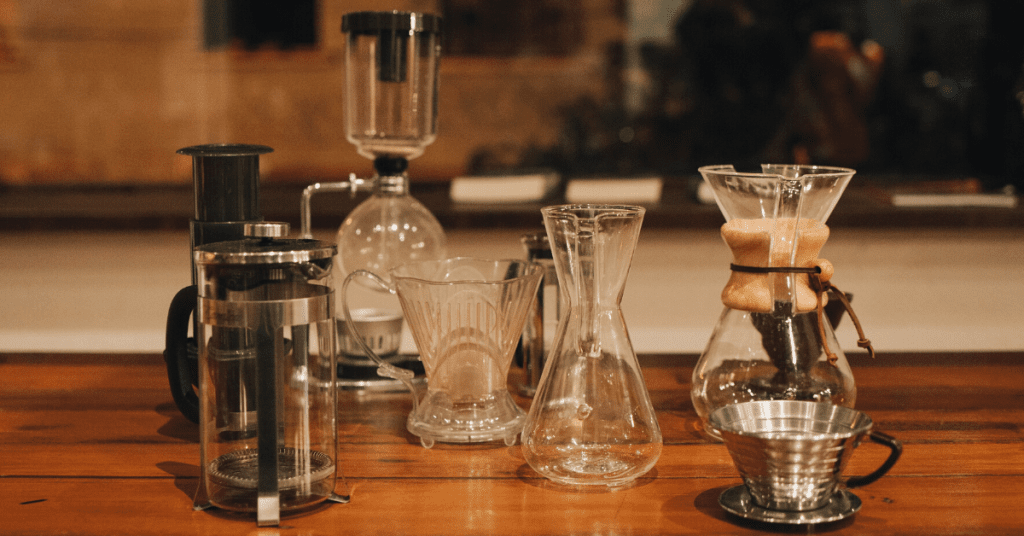
Photo by Nathalia Segato on Unsplash
In comparison with espresso, drip coffee is the result of wetting a conic bed of coffee grounds with hot water. When coffee grounds and water meet, water dissolves coffee partially. Then, we let it drip over a filter. This extraction process is crucial. To some extent, this is the difference between coffeemakers and espresso machines too.
Some coffeemakers like the French press and Clever use immersion instead of percolation, but neither exert pressure over a coffee bed, as an espresso machine does.
Like espresso, grinds size plays a major role in coffee taste. It is common to get a weak cup of coffee after grinding too coarse, and it’s even more frequent to get bitter cups of coffee due to excessively fine coffee grounds, or too many fines.
Still, due to the absence of pressure, and the type of filters we use for regular coffee, it’s considerably less concentrated than espresso. For this reason, even if we try to brew filter coffee with a very little amount of water, it will be considerably weaker than espresso.
Paper filters for home coffee makers stop most oils from getting into the cup, as well as fine particles. For this reason, drip coffee usually offers a cleaner cup with no residues.
This isn’t the case for the French press and Moka pot. Metal filters allow more particles to get into the cup that results in a thicker and richer body. In any case, a French press or a Moka pot won’t get anything close to espresso, because they don’t produce 9 bars of pressure.
While this is visually evident, because Moka pot and French coffee don’t produce crema, the body, mouthfeel, and taste of espresso are significantly different too.
Roast
The real difference between coffee and espresso beans doesn’t come from the plant or a specific variety. Typically, espresso beans are dark roasts, while regular coffee beans tend to be medium roasts.
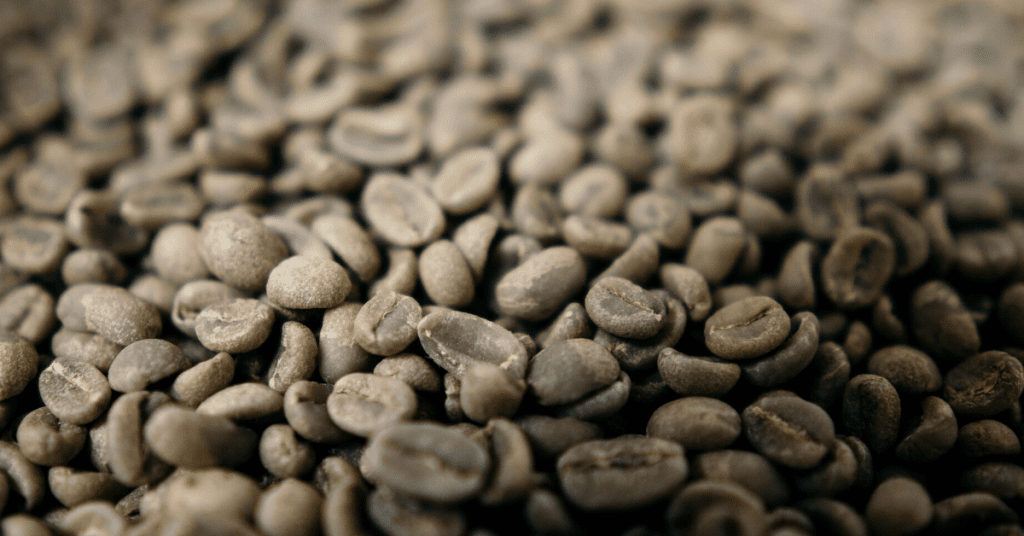
Photo by Battlecreek Coffee Roasters on Unsplash
Still, it’s more common to find robusta coffee beans in espresso coffee beans, than in most commercial coffee. Italians are particularly fond of this practice because robusta produces a richer and stable crema. Moreover, robusta contains more caffeine and, as a result, a more bitter taste too.
Now, getting back to roasting, there are some interesting changes that are challenging coffee traditions.
For the past few decades, roasters and big coffee brands have been experimenting with roasting types and profiles, and it’s easier to find medium roasts in espresso.
Although dark roasts are strongly rooted in tradition, they’re tricky because they hide defects in low-quality coffee. For this reason, many coffee enthusiasts link dark roasts with low-quality coffee.
Additionally, dark roasts stale faster, particularly if they look oily. However, as dark roasts produce more crema and offer a bitter, less acidic taste, it’s the favorite of more traditional espresso enthusiasts.
Roasting coffee is a very complex process, and coffee blends for espresso tend to look for naturally occurring nutty and chocolatey flavors. Acidity, although most recently accepted in modern espresso, can be overwhelming if the roast is too light.
In sum, dark roasts are still more common for espresso, but that doesn’t mean that you can’t use dark roasts for drip coffee or medium roasts for espresso.
Serving size
After looking closely at the process, it’s easier to look at the result.
Serving sizes of espresso and regular coffee are very different. An espresso shot can have something between 15 ml to 20 ml, and as double shots are becoming the standard, it’s common to find espressos around 40 ml.
In contrast, we fill our 500 ml mugs with black coffee, and some of them are even larger.
This is something that we can’t take lightly. Regardless of price and quality, capacity is a major difference between the coffee maker and the espresso machine.
Body
The body affects both the texture, mouthfeel, and perceived density of the coffee drink. It’s a major difference between black coffee and espresso, and for many people is as important as taste.
The mouthfeel and thick body of espresso come mainly from coffee concentration, but the extraction process plays a huge role in this. Crema is essential for the enjoyment of the body of espresso because it makes it frothy.
Call me a romantic, but sensing this thin layer of foam with your lips is like a very delicate kiss.
But the texture isn’t everything. I will talk about the role of crema for taste below. There are some interesting nuances about stirring or skimming crema off the espresso.

Photo by Najla Cam on Unsplash.
The black coffee body is completely different and depending on the brewing ratio it can be watery or bold. Still, as I explained before, it doesn’t matter how much coffee we put in a coffee maker, it will never produce anything close to espresso.
The Moka pot and the Aeropress are the only coffeemakers capable of brewing a cup of coffee with a similar body.
Taste and aroma
Espresso offers a more intense taste, with a couple of dominant notes. Flavors in an espresso shot vary widely depending on the coffee beans, but many coffee blends for espresso favor chocolate and nutty flavors.
Innovative roasters have experimented with more acidic, floral, and fruity profiles that can produce completely surprising espresso shots.
But in short, taste is king for espresso and coffee in general.

Photo by Candice Picard on Unsplash
An overly bitter shot isn’t any better than a sour shot. The balance of a good espresso depends heavily on grind size, dosing, and pressure. However, other factors can play a role, particularly if the coffee equipment isn’t properly maintained and the water quality isn’t appropriate.
Although we talked about crema when explaining the body, it’s important for taste too. Crema adds significant bitterness to the shot. Some claim that stirring the espresso will make it more balanced, while others prefer to skim the crema off the espresso.
This is, for sure, a matter of opinion, and some appreciate espresso bitterness as part of the drink’s character. So, I will let you be the judge here and decide what’s best for your espresso.
In contrast, black coffee has more water than espresso. Brewing with a dripper like a V60 or a Chemex will usually result in a clean, light-bodied cup of coffee. As I said before, this doesn’t depend only on the coffeemaker, but on the brewing ratio.
Convention dictates that we can get the best of filter coffee using something 14:1 and 20:1 brewing ratios. And taste and aroma change significantly inside this range.
Unlike espresso, filter coffee taste complexity is richer, although it lacks intensity. As a delicate cup of Chemex coffee cools down, you’ll invariably notice new flavors and aromas emerge from the cup. Something that’s not as common with espresso.
For this reason, many prefer to choose light and medium roasts for filter coffee. Picking single origins and experimental processing methods are very interesting when using a dripper. A more diluted coffee helps to identify different notes, and most of the time it won’t make a good drink with creamer or milk.
Milk and creamers dull drip coffee subtle taste and aroma, so if you feel like make it milk-based coffees, I recommend using a stronger brew ratio -nothing lighter than 12:1. Additionally, dark roasts tend to work better with milk, particularly those with strong chocolate notes.
Caffeine content
It’s hard to believe, but we tend to get a higher caffeine intake by drinking regular coffee than from espresso.
Sure, espresso is more concentrated, so it has more caffeine per ml. However, larger serving sizes for drip coffee result in having more caffeine per serving.
For instance, a mug of black coffee made with 20 gr will typically result in higher caffeine content than an espresso made with 10 gr of coffee.
Now, this only applies if we use the same coffee beans for making espresso and regular coffee. As I said above, some coffee blends have robusta, a coffee bean with as much as twice the caffeine than arabica. Using robusta for making coffee will always get you a stronger caffeine fix.
Bear in mind, though, that it takes a very fine robusta to get a pleasant taste.
The espresso shot: A closer look
Traditionally, espresso comes in a small 50 ml cup of coffee.
Recently, double-walled glasses are becoming popular for serving espresso, but the serving size remains small. One of the reasons for the increasing popularity of double-walled glasses for espresso is the visual appeal of the thin caramel-colored crema on top of the rich, dark brown of the espresso liquid.
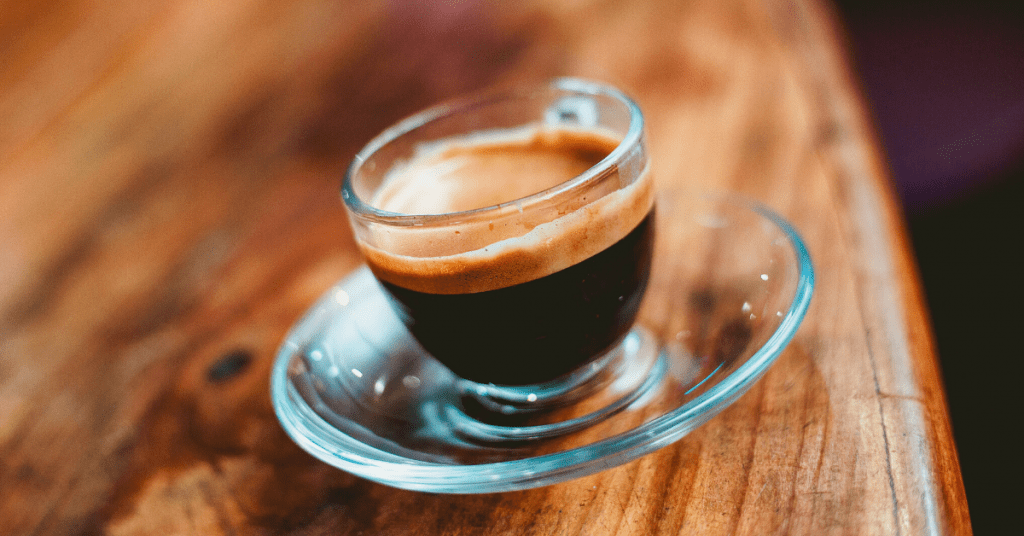
Photo by nitin pariyar on Unsplash
But, is crema important?
Crema explained
Espresso lovers are crazy about crema, and it’s the first thing you can see -literally- to know if espresso is good.
Facts about crema
- Crema has emulsified oils, but fatty coffee beans tend to produce a less stable foam than low-fat ones.
- Coffee grounds release CO2 due to extreme pressure. This gas creates tiny bubbles that make the thin layer of foam, or crema.
- Darker roasts produce more crema than lighter roasts.
- Fresher coffee will give you more crema than older coffee.
- The color of crema depends on roasting types and espresso strength.
- Dialing an espresso shot with no crema is a definite sign that something is wrong.
- Tiger stripes or flakes are tiny particles of coffee that go through the filter. These are more common with dark roasts, and some claim that these add both for the aesthetics and bitterness of the espresso.
- Robusta produces more crema than Arabica because it has almost double the CO2 after roasting. Additionally, it has fewer oils so the crema from robusta is more stable as well.
Final Thoughts
After reading this blog post, I hope that the next time a friend asks what is the difference between espresso and coffee, you’ll be better prepared.
After reading this blog post, I hope that the next time a friend asks what is the difference between espresso and coffee, you’ll be better prepared.
In essence, the difference between filter coffee and espresso is the result of a different brewing process, that many times considers roasting coffee beans differently. Such differences, in terms of coffee preparation, boil down to:
- Roast
- Grind size
- Brewing gear
- Dosing
In terms of the result, the difference between brewed coffee and espresso are:
- Serving size
- Body and crema
- Taste and aroma
- Caffeine content
Common doubts about espresso and drip coffee
Making an espresso shot at home isn’t for the faint of heart. It takes a lot of discipline, curiosity, and skill to get there.
Find below some of the most common doubts I found when researching for this blog post.
How do espresso and coffee differ in taste?
The preparation method of espresso and coffee produce very different results. An espresso shot’s taste is intense, enhancing its acidity, and bitterness.
Still, bear in mind that taste depends on the quality and roast type of the coffee beans, water, and brewing ratio.
Is Espresso Healthier Than Drip Coffee?
Espresso has the higher antioxidant content any beverage could have, even superior to drip coffee. Additionally, taking 3 espressos in a day usually means having less caffeine than 3 mugs of drip coffee.
All of this assuming that we are using the same beans for espresso and regular coffee.
Why Is Espresso More Expensive Than Drip Coffee?
Coffee equipment for espresso making is expensive. Proper maintenance for this equipment is laborious and requires technical expertise.
Most importantly, brewing a cup of espresso requires concentration for each extraction, while drip coffee can be made in batches.
Even a fully focused barista can prepare a 600 ml serving of filter coffee in a single effort, while the same persona can’t focus on more than two espresso shots at once.
Are Espresso Blends A Darker Roast Than Drip Coffees?
Espresso blends tend to be darker than regular roasts for home coffee makers. Furthermore, filter coffee enthusiasts like to experiment with medium and light roasts because they provide more complex cups of coffee, with interesting tastes and aromas.
Dark roasts tend to have more character but have simpler aromatic profiles too.
Read next
- The Best Espresso Machine for Home: The Ultimate Buying Guide
- Best Grind And Brew Coffeemaker
- 9 common myths about espresso
Credits
Featured image based on the photo by Taylor Wilcox on Unsplash


